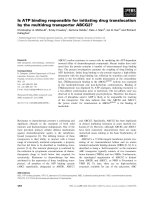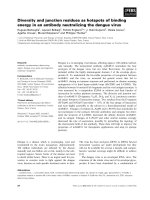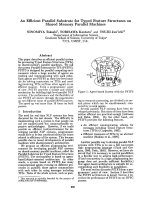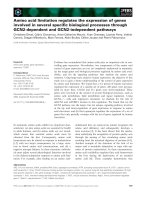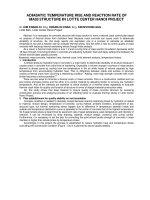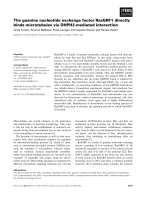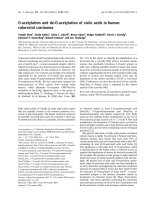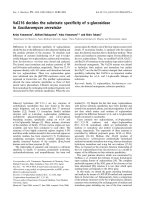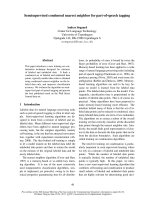báo cáo khoa học: " Kinesin-5 motors are required for organization of spindle microtubules in Silvetia compressa zygotes" doc
Bạn đang xem bản rút gọn của tài liệu. Xem và tải ngay bản đầy đủ của tài liệu tại đây (994.94 KB, 10 trang )
BioMed Central
Page 1 of 10
(page number not for citation purposes)
BMC Plant Biology
Open Access
Research article
Kinesin-5 motors are required for organization of spindle
microtubules in Silvetia compressa zygotes
Nick T Peters* and Darryl L Kropf
Address: Department of Biology, University of Utah, Salt Lake City, UT 84112, USA
Email: Nick T Peters* - ; Darryl L Kropf -
* Corresponding author
Abstract
Background: Monastrol, a chemical inhibitor specific to the Kinesin-5 family of motor proteins,
was used to examine the functional roles of Kinesin-5 proteins during the first, asymmetric cell
division cycle in the brown alga Silvetia compressa.
Results: Monastrol treatment had no effect on developing zygotes prior to entry into mitosis.
After mitosis entry, monastrol treatment led to formation of monasters and cell cycle arrest in a
dose dependent fashion. These findings indicate that Kinesin-5 motors maintain spindle bipolarity,
and are consistent with reports in animal cells. At low drug concentrations that permitted cell
division, spindle position was highly displaced from normal, resulting in abnormal division planes.
Strikingly, application of monastrol also led to formation of numerous cytasters throughout the
cytoplasm and multipolar spindles, uncovering a novel effect of monastrol treatment not observed
in animal cells.
Conclusion: We postulate that monastrol treatment causes spindle poles to break apart forming
cytasters, some of which capture chromosomes and become supernumerary spindle poles. Thus,
in addition to maintaining spindle bipolarity, Kinesin-5 members in S. compressa likely organize
microtubules at spindle poles. To our knowledge, this is the first functional characterization of the
Kinesin-5 family in stramenopiles.
Background
Fucoid algae are model organisms uniquely suited for
studies investigating cellular polarity and asymmetric
division during development. The fucoid marine brown
alga Silvetia compressa, a member of the stramenopile lin-
eage, displays oogamous fertilization in which a large ses-
sile egg is fertilized by a small motile sperm [1]. The eggs
and zygotes are large, about 100 μm in diameter, facilitat-
ing physiological and microscopic investigations [2].
Large numbers of zygotes, released into the surrounding
seawater, can be easily collected for experimentation [3].
Zygotes develop synchronously during the first division
cycle, completed about 24 h after fertilization (AF) with
an invariant, asymmetric cell division [4]. From fertiliza-
tion through cell plate deposition, a dynamic microtubule
(MT) network is utilized for multiple cellular processes
including migration of the male pronucleus, separation of
the centrosomes around the nuclear envelope, nuclear
positioning and rotation, formation and maintenance of
a properly positioned mitotic spindle, and formation of a
cytokinetic plane that bisects the spindle [5]. Numerous
investigations of cytoskeletal proteins in S. compressa have
provided a framework for more detailed studies examin-
ing the function of cytoskeletal associated proteins,
Published: 31 August 2006
BMC Plant Biology 2006, 6:19 doi:10.1186/1471-2229-6-19
Received: 16 June 2006
Accepted: 31 August 2006
This article is available from: />© 2006 Peters and Kropf; licensee BioMed Central Ltd.
This is an Open Access article distributed under the terms of the Creative Commons Attribution License ( />),
which permits unrestricted use, distribution, and reproduction in any medium, provided the original work is properly cited.
BMC Plant Biology 2006, 6:19 />Page 2 of 10
(page number not for citation purposes)
including molecular motors [4,6,7]. This study examines
the Kinesin-5 family of motors during early S. compressa
development.
The kinesin superfamily proteins (KIFs) are a diverse and
evolutionarily conserved group of molecular motors
present in metazoans, plants, fungi, and protozoans [8].
Kinesins possess a ~360 amino acid residue globular
"motor" domain that hydrolyzes ATP for movement
along MTs [8]. Kinesins travel towards the plus or minus
end of MTs, or perform more structural roles in MT organ-
ization and stability [9]. The "tail" domains of kinesins
are much less conserved and can mediate formation of
higher order structures with fellow kinesins or attachment
of cargos to be transported along MTs [8]. Recent work has
categorized kinesin family members into 14 different
classes which function in a multitude of cellular processes
[9]. While human and fly kinesins have recently been sys-
tematically examined to determine their roles in cellular
and developmental processes [10,11], the functional roles
of kinesins in stramenopiles have not been investigated.
Monastrol and a chemical analogue S-trityl-L-cysteine
(STLC) are small, cell-permeable inhibitors of the
Kinesin-5 family of plus-end directed motors [12].
Kinesin-5 motors are bipolar homotetramers with two
motor domains at each end, separated by a stalk/tail
region [13]. Kinesin-5 motors are localized to the nucleus
in animal cells until nuclear envelope breakdown at the
onset of mitosis [14]. Inhibition of this motor has severe
effects in mitosis but little or no effect in interphase [15].
During mitosis, Kinesin-5 motors function near the spin-
dle midzone to maintain pole to pole distance. Motor
domains attach to MTs from opposite poles and translo-
cate towards the plus ends, thereby pushing spindle poles
apart [16]. Additionally, Kinesin-5 proteins have been
observed at spindle poles, though their function at that
location is unclear [16,17]. Monastrol acts by specifically
binding to and inhibiting the motor domain of Kinesin-5
proteins, thus impeding processive movement, while not
affecting MT binding interactions [18]. Inhibition of
processive movement of motors at the spindle midzone
leads to formation of "monaster" spindles during met-
aphase. Monasters are defined by collapse of the spindle
poles to a single focus, with captured chromosomes at the
distil, plus ends [18].
To begin addressing the functional roles of kinesins dur-
ing development in S. compressa, we examined the effects
of monastrol treatment on the first asymmetric cell divi-
sion cycle. We found that monastrol treatment induced
formation of monasters upon entry into mitosis, confirm-
ing previous findings with animal systems [18]. Novel
structures were also observed following drug treatment;
multiple cytasters were observed throughout the cyto-
plasm and many cells formed multipolar spindles. There
was a strong correlation between the presence of cytasters
and multipolar spindles. These findings suggest that
monastrol induces spindle pole breakup at mitosis entry,
resulting in formation of cytasters, some of which become
supernumerary spindle poles. Thus, Kinesin-5 members
in S. compressa, and perhaps in other stramenopiles,
appear to function not only at the spindle midzone to
generate bipolarity, but also at spindle poles to maintain
pole integrity.
Results
Monastrol or STLC treatment induced formation of
monasters and multipolar spindles
To determine the functions of Kinesin-5 motors in brown
algal cells, monastrol (25 μM – 100 μM) and a more
potent chemical analogue, STLC (0.5 μM – 10 μM), were
applied to S. compressa zygotes at 6 h AF. Cells were subse-
quently fixed at 16, 24, and 48 h AF, and fluorescently
labeled with antibodies to observe MTs and condensed
chromatin by confocal microscopy (see Materials and
Methods). Monastrol had no effect on development or
MT arrays of zygotes observed 16 h AF, prior to entry into
mitosis. Treated zygotes germinated in accordance with an
orienting light vector and had extensive MT arrays ema-
nating from centrosomes on opposite sides of the nucleus
(Fig. 1A–C). This finding suggests nuclear sequestration of
Kinesin-5 motors during interphase, as has been reported
in animal cells [10,19,20].
Normal metaphase spindles are characterized by two dis-
tinct spindle poles, consisting of centrioles and a cloud of
hundreds of pericentriolar matrix proteins [21], spindle
MTs and condensed chromatin at a metaphase plate (Fig.
1D). Treatment with monastrol severely disrupted spindle
formation and resulted in monaster formation in some
zygotes (Fig. 1E–F). Monasters, astral arrays of MTs with
condensed chromatin near the periphery of the array,
were similar to those observed in monastrol-treated or
Kinesin-5-depleted animal cells [10,19,20]. Intense labe-
ling of MTs in monasters is consistent with large numbers
of short MTs in close proximity [16]. These results indicate
that monastrol and STLC specifically inhibit brown algal
Kinesin-5 motors that are critical for bipolar spindle
assembly and maintenance. Although both drug treat-
ments had similar effects on zygotes, monastrol treatment
produced the most consistent results and was therefore
the main focus for subsequent work.
Surprisingly, most treated cells formed multipolar spin-
dles rather than monasters at entry into mitosis. Multipo-
lar spindles have not been observed in other organisms
treated with monastrol. The structure of multipolar spin-
dles was quite variable, ranging from three spindle poles
arranged linearly with chromosomes between poles to
BMC Plant Biology 2006, 6:19 />Page 3 of 10
(page number not for citation purposes)
Monastrol and STLC treatment of S. compressa zygotesFigure 1
Monastrol and STLC treatment of S. compressa zygotes. (A-C) Zygotes were not sensitive to monastrol treatment during inter-
phase (16 h AF); (A) 0.2% DMSO (B) 25 μM monastrol, (C) 50 μM monastrol. Note that the interphase zygotes in B and C
exhibit elongated nuclei, indicating that they developed slightly faster than the control zygote in A. However, differences in
developmental timing between treatments were not routinely observed. (D-F) Formation of monasters in mitosis (24 h AF);
(D) 0.2% DMSO, (E) 25 μM monastrol, (F) 5 μM STLC. (G-I) Multipolar spindles (24 h AF); (G) 25 μM monastrol, (H) 50 μM
monastrol, (I) 0.5 μM STLC. (J-L) Cytaster formation; (J) 25 μM monastrol (24 h AF), (K) 50 μM monastrol (24 h AF), (L) 100
μM monastrol (48 h AF). Cytasters were observed scattered throughout the cytoplasm. Hours in parentheses indicate times at
which zygotes were fixed. MTs are depicted in green, condensed chromatin is depicted in red, and overlap between MTs and
condensed chromatin is depicted in yellow. Median optical sections, 10–20 μm in total thickness, are shown. Scale bars equal
10 μm.
BMC Plant Biology 2006, 6:19 />Page 4 of 10
(page number not for citation purposes)
three or more poles in various spatial arrangements with
captured chromosomes at metaphase plates (Fig. 1G–I).
Chromosomes captured by a single spindle pole were also
observed, but "lost" chromosomes unassociated with
spindle MTs were not found. Multipolar spindles were the
predominant mitotic structure in treated cells, and were
observed in 70–80% of the population (Fig. 2A). The
remaining 20–30% of the population had normal MT
arrays or monasters in roughly equal proportions. Regard-
less of spindle morphology, pole-to-pole separation was
reduced in a dose dependent manner by monastrol treat-
ment (Fig. 2B), consistent with the postulated role of
Kinesin-5 in generating spindle bipolarity.
Cytasters were present in most treated cells
Most treated cells observed after entry into mitosis pos-
sessed cytasters (Fig. 1H, J–L). Cytasters are supernumer-
ary MT organizing centers (MTOCs) [22]. These structures
are reminiscent of the star-shaped MT-based structures
observed in the Fucus serratus cell cortex by Corellou et al.
[7]; however, in our study cytasters were only observed
after monastrol treatment and were distributed through-
out the cytoplasm. MTs in cytasters were shorter than cen-
trosomal MTs of untreated controls. Cytasters were
present in nearly all zygotes that had multipolar spindles,
while less than half of zygotes with monasters displayed
cytasters (Fig. 2C). The strong correlation between
multipolar spindles and cytasters suggests that cytasters
may function as supernumerary spindle poles. Like
multipolar spindles, cytasters have not been observed in
other cell types or organisms treated with monastrol.
Monastrol treatment delays or inhibits cell division
Monastrol delayed cell division at low drug concentra-
tions and inhibited cell division at higher concentrations
(Fig. 3A). While cell division was significantly reduced by
all drug treatments at 24 h AF, most zygotes treated with
25 μM monastrol had divided by 48 h AF. By contrast,
treatment with higher drug concentrations (50 μM – 100
μM) resulted in sustained inhibition of cell division in a
dose dependent fashion. The monastrol concentrations
leading to cell cycle arrest are consistent with IC
50
values
reported for inhibition of ATP binding by a racemic mix-
ture of monastrol [18], providing further evidence that
monastrol specifically targets S. compressa Kinesin-5.
Many undivided cells appeared to be arrested in first mito-
sis as judged by prolonged phosphorylation of histone
H3. Histone H3 is phosphorylated from late prophase
until global dephosphorylation during anaphase [23]. At
48 h AF, the percent of undivided zygotes with persistent
histone H3 phosphorylation was concentration depend-
ent in monastrol (Fig. 3B). In 100 μM monastrol, 66.5 ±
10.1 percent of the undivided cells exhibited condensed
chromatin. These zygotes had likely arrested at the spindle
assembly checkpoint of the first cell cycle [24]. Indeed,
when the spindle assembly checkpoint was activated by
MT stabilization using paclitaxel or MT depolymerization
Monastrol or STLC treatment induced formation of multipo-lar spindles with reduced pole-to-pole distance at 24 h AFFigure 2
Monastrol or STLC treatment induced formation of multipo-
lar spindles with reduced pole-to-pole distance at 24 h AF.
(A) Incidence of monasters, multipolar spindles and normal
MT arrays with increasing monastrol concentration. Zygotes
with normal MT arrays had progressed beyond metaphase at
24 h AF; most were in telophase. (B) Pole-to-pole distance.
For multipolar spindles, only the greatest distance between
any two spindle poles sharing captured chromosomes was
measured. Pole-to-pole distance was significantly (p < 0.001,
Student's t test) shorter in all drug treatments compared to
controls, and all treatments were significantly different from
each other. (C) Multipolar spindles were associated with
cytasters. Open bars; percent of the cells with monasters
that also had cytasters. Shaded bars; percent of cells with
multipolar spindles that also had cytasters.
BMC Plant Biology 2006, 6:19 />Page 5 of 10
(page number not for citation purposes)
using oryzalin, nearly all zygotes exhibited prolonged his-
tone H3 phosphorylation (Fig. 3B).
Spindle and division plane alignment
Metaphase spindles in untreated cells were reasonably
well aligned with the growth axis and resided near the
center of the zygote (Fig. 1D). Interestingly, aberrant spin-
dles in monastrol-treated zygotes were often displaced
toward the rhizoid (Fig. 1E–L). Condensed chromatin was
also incorrectly positioned following MT depolymeriza-
tion by oryzalin or MT stabilization by paclitaxel, as has
been previously reported [25]. However, preferential dis-
placement toward the rhizoid was not observed in paclit-
axel or oryzalin; chromatin position instead appeared
more random (data not shown). Together these findings
support the hypothesis that MTs are crucial for spindle
positioning [26,27].
S. compressa zygotes determine division plane based on
spindle position [26], so monastrol treatment was pre-
dicted to alter division patterns. The first asymmetric divi-
sion in untreated zygotes bisected the spindle and
therefore was transverse to the growth axis (arrowhead,
Fig. 4A). Since few zygotes treated with 100 μM monastrol
divided, we focused on lower drug concentrations. As
expected, aberrant division planes (assessed as >30
degrees from perpendicular to the long axis of the cell)
were observed in cells treated with 25 μM or 50 μM
monastrol (Fig. 4B). In addition, curved planes of division
were also observed (Fig. 4C). The percent of cells with
abnormal division planes increased with monastrol con-
centration; at 50 μM approximately two thirds of divided
cells displayed aberrant division planes (Fig. 4C).
MT disruption slows tip growth
Rhizoids of zygotes treated with paclitaxel, oryzalin or
monastrol appeared shorter and broader than control
rhizoids (Fig. 5B–E). We therefore assayed tip growth by
measuring the length of the embryonic axis over a three-
day period. None of the pharmacological agents affected
rhizoid growth prior to mitosis; zygotes elongated at ~1
μm/h regardless of treatment (Fig. 5A). Although control
embryos continued to elongate at ~1 μm/h after first divi-
sion, tip elongation was severely reduced in treated
zygotes following entry into first mitosis. This growth
reduction was probably not due to MT disruption since
treated zygotes grew normally prior to mitosis, nor was it
likely caused by a cell volume checkpoint. Fucoid zygotes
treated with aphidicolin activate an S-phase cell cycle
checkpoint that blocks nuclear division and cytokinesis,
but permits continued rhizoid tip growth [24]. This
results in very large, elongated zygotes that are undivided,
suggesting that zygotes do not possess a volume check-
point. Instead, the abrupt reduction in growth rate we
observed was probably caused by arrest in M phase, per-
haps via activation of the spindle assembly checkpoint
[28].
Discussion
Although assembly of a mitotic spindle is not well under-
stood, the process requires dynamic MTs, plus-end and
minus-end directed MT motors, and a plethora of acces-
sory proteins, including static crosslinking molecules
[29]. Kinesin-5 motors localize within the nucleus until
nuclear envelope breakdown (NEB) [14] when they are
released into the cytoplasm and accumulate at the mid-
zone and poles of the forming spindle. They are required
for maintenance of bipolar spindle integrity and poleward
flux of MTs [30]. In the midzone, Kinesin-5 motors inter-
act with MTs from opposite poles and move at ~20 nm s
-
1
toward MT plus-ends, effectively pushing spindle poles
apart [16]. Inhibition of Kinesin-5 function by gene
knockout, RNAi-mediated depletion, or treatment with
pharmacological agents results in monaster formation
during spindle assembly [10,11,19]. For example, muta-
tions in Drosophila KLP61F, a Kinesin-5 ortholog, have
Monastrol treatment led to cell cycle delay at low concentra-tions and cell cycle arrest at high concentrationsFigure 3
Monastrol treatment led to cell cycle delay at low concentra-
tions and cell cycle arrest at high concentrations. (A) Filled
triangles depict cell plate formation at 24 h AF, and open
squares depict cell plate formation at 48 h AF. (B) Chromatin
condensation in undivided cells at 48 h AF assayed by labeling
with antibody to phosphorylated histone H3. Bars are stand-
ard errors.
BMC Plant Biology 2006, 6:19 />Page 6 of 10
(page number not for citation purposes)
Monastrol concentrations permissive for cell division led to aberrant cytokinesis assayed at 48 h AFFigure 4
Monastrol concentrations permissive for cell division led to aberrant cytokinesis assayed at 48 h AF. (A) 0.2% DMSO. By 48 h
AF, control zygotes had divided several times in a stereotypical pattern. Arrowhead indicates first division plane. (B-C) 25 μM
monastrol. Asterisks mark aberrant division planes. (D) Percent of divided zygotes with abnormal first cytokinesis, as assessed
by >30 degree deviance from perpendicular to the long axis of the cell, or by curved cell plates. Standard error bars shown.
Scale bars equal 10 μm.
BMC Plant Biology 2006, 6:19 />Page 7 of 10
(page number not for citation purposes)
been shown to disrupt maintenance of spindle pole sepa-
ration [31]. Kinesin-5 proteins act in concert with other
spindle associated proteins to maintain proper spindle
length. For example, increasing the levels of NuMA, a MT
crosslinking protein, restores spindle bipolarity in mitotic
extracts lacking Kinesin-5 activity [32]. In sum, animal
Kinesin-5 motors function with other mitotic proteins to
generate and maintain pole-to-pole separation by push-
ing apart antiparallel MTs at the spindle midzone.
The roles of kinesins in the stramenopile lineage have not
been functionally investigated. We examined the roles of
Kinesin-5 motors during the first cell division cycle in S.
compressa by employing Kinesin-5-specific inhibitors to
brown algal zygotes. S. compressa zygotes treated with
monastrol (or STLC) appeared normal and had normal
MT arrays in interphase of the first cell cycle, consistent
with nuclear localization prior to NEB. Unfortunately, we
were unable to confirm nuclear localization since availa-
ble antibodies to animal Kinesin-5-proteins did not label
fucoid zygotes. Importantly, monasters were formed
upon entry into mitosis. These findings are similar to
reports in animals [10,11,19] and indicate that monastrol
binds and inhibits Kinesin-5 motors in S. compressa. How-
ever, monastrol had additional effects on zygotes not
observed in animal cells; in addition to monasters,
multipolar spindles and cytasters were formed at mitotic
entry.
Multipolar spindles were formed at a much higher fre-
quency than monasters, indicating that spindle poles do
not fully collapse when Kinesin-5 motors are inhibited.
This is unrelated to monastrol dosage since increasing
concentration did not significantly increase monaster fre-
quency. Instead, zygotes probably possess other mecha-
nisms that work in concert with Kinesin-5 to maintain
pole separation. There may be MT-based motors with
overlapping function or MT crosslinking proteins, such as
NuMA, that continue to function in the presence of
monastrol, maintaining some pole separation. Centro-
some position at the onset of mitosis may also contribute
to the relatively low monaster frequency. Brown algal cen-
trosomes are fully separated on the nuclear envelope prior
to entry into mitosis, residing about 15 μm apart [33].
Animal centrosomes, however, separate concurrent with
NEB so spindle poles are still close together when Kinesin-
5 motors become active [34]. The greater separation of
algal spindle poles may reduce the likelihood of complete
spindle collapse to a monaster during drug treatment.
The presence of multipolar spindles also implies that
supernumerary spindle poles are formed at entry into
mitosis, and the extra poles may be derived from cytasters.
Although the composition of fucoid cytasters is unknown,
they are distinct small astral-like radial bursts of MTs.
These are commonly associated with centrin labeling in
other systems, and are likely MTOCs [22]. The observa-
tion that nearly all zygotes with multipolar spindles addi-
tionally displayed cytasters, while cytasters were only
Monastrol, paclitaxel, and oryzalin severely reduce tip growth at first mitosisFigure 5
Monastrol, paclitaxel, and oryzalin severely reduce tip
growth at first mitosis. (A) Embryonic growth over a 72 h
period. Data are from one representative experiment sam-
pling ten undivided zygotes for each treatment. Diamonds,
0.2% DMSO; triangles, 5 μM paclitaxel; squares, 3 μM oryza-
lin; circles, 50 μM monastrol. Standard error bars are shown.
(B-E) Images of treated zygotes at 72 h AF. (B) 0.2% DMSO,
(C) 50 μM monastrol (D) 5 μM paclitaxel, (E) 3 μM oryzalin.
Scale bar equals 100 μm.
BMC Plant Biology 2006, 6:19 />Page 8 of 10
(page number not for citation purposes)
present in about half of cells with monasters, suggests a
causal a link between cytasters and supernumerary spin-
dle poles. We speculate that monastrol treatment leads to
spindle pole breakup in S. compressa and fragments of
spindle poles nucleate MTs and become cytasters. Numer-
ous cytasters are located throughout the cytoplasm of
treated cells, and occasionally one residing close to con-
densed chromatin captures chromosomes, thereby
becoming a supernumerary spindle pole. In this model,
Kinesin-5 motors must organize and maintain the integ-
rity of spindle poles. Kinesin-5 members residing at spin-
dle poles have been postulated to bundle long MTs [35],
sort numerous short MTs in the cloud of spindle pole pro-
teins [16], and/or mediate attachment to a hypothesized
scaffold-like spindle matrix [35]. In fucoid zygotes, one or
more of these putative functions may be needed to hold
pole components together.
Interestingly, the vast majority of zygotes treated with
monastrol had aberrant spindles that were displaced from
a central cellular position toward the rhizoid. Proper
alignment of the mitotic spindle in brown algae has been
shown to be a MT-dependent process [27], and we
observed that condensed chromatin was displaced in
zygotes treated with paclitaxel or oryzalin (data not
shown). MTs that position the fucoid spindle are thought
to do so by interacting with the cell cortex before and after
metaphase [26]. Perhaps the dramatically prolonged met-
aphase during monastrol treatment permits unregulated
spindle movement, resulting in aberrant spindle position.
Even so, it is not clear why the spindles preferentially drift
in the rhizoid direction.
Cytokinesis bisects the spindle in fucoid zygotes [27], so
it was not surprising to find abnormal divisions following
monastrol treatment. The preponderance of multipolar
spindles likely resulted in many of the abnormal divi-
sions. Some zygotes with multipolar spindles must still
progress through mitosis because the vast majority of cells
treated with 25 μM monastrol display multipolar spindles
at 24 h AF but completed cell division by 48 h AF. The
spindle assembly checkpoint apparently does not moni-
tor spindle pole number. Likewise, cytokinesis proceeds
in sea urchin zygotes and in vertebrate somatic cells pos-
sessing supernumerary spindle poles [36]. Since it is
unlikely that monaster spindles could achieve equivalent
kinetochore tension on chromosomes, these zygotes
probably remained arrested in metaphase and failed to
divide. Therefore, most abnormal division planes in
monastrol-treated S. compressa zygotes are likely due to
multipolar or abnormally positioned spindles that
achieve balanced kinetochore attachments, permitting
cell cycle progression and aberrant placement of the
cytokinetic plane.
Future studies will be aided by an ongoing genomic
sequencing project of closely related Ectocarpus siliculosis
[37] and by creation of an EST database for fucoid algae.
This information will permit isolation of S. compressa
Kinesin-5 sequences for use in molecular investigations
and antibody production, and may provide insight into
what elements, beyond MTs, are associated with cytasters.
Conclusion
Kinesin-5 motor proteins are necessary for bipolar spindle
formation during mitosis in brown algal cells, similar to
what has been previously reported in animals. In addi-
tion, they appear to be involved in maintaining spindle
pole integrity.
Methods
Sexually mature fronds (receptacles) of the fucoid algae S.
compressa were collected near Santa Cruz, California,
shipped cold and stored in the dark at 4°C until use.
Receptacles were potentiated by placing them under 100
μmol·m
-2
·s
-1
light at 16°C in artificial sea water (10 mM
KCL, 0.45 M NaCl, 9 mM CaCl, 16 mM MgSO
4
, 0.040 mg
chloramphenicol per ml, buffered to a pH of 8.2 with Tris
base) for 1 to 3 h. Potentiated receptacles were then
washed with ASW and placed in the dark for 1 h to induce
gamete release. The time of fertilization was taken to be
the midpoint of the dark period. Zygotes were plated onto
coverslips in plastic dishes and grown in ASW with unidi-
rectional light at 16°C until harvest. All experiments were
performed in triplicate. Graphs depict data compiled from
three experiments, unless otherwise noted.
Pharmacological agents were dissolved in DMSO to create
stock solutions of 100 mM monastrol (AG Scientific, San
Diego, Ca.), 50 mM S-trityl-L-cysteine (Sigma, St. Louis,
Mo.), 10 mM paclitaxel (taxol, Sigma, St. Louis, Mo.) and
10 mM oryzalin. Since monastrol is light sensitive, degra-
dation was tested by exposing 100 μM monastrol in ASW
in culture dishes to unilateral light for three days. Similar
levels of inhibition of cell division were observed for both
fresh and light-treated monastrol, indicating no signifi-
cant degradation. Drugs were applied to zygotes at various
times prior to mitotic entry, yielding similar results. For all
work presented here, drugs were added chronically to
zygotes beginning 6 hours after fertilization (h AF).
Appropriate controls were performed with DMSO at con-
centrations corresponding to the maximum volume of
drug used. These controls showed normal development.
Pharmacological effects on tip growth were evaluated by
capturing sequential images of individual embryos over
three days with a coolSNAP (RS Photometrics) camera on
an Olympus IMT2 microscope. Embryonic length was
measured using Photoshop 7.0 (Adobe, San Jose, Ca).
BMC Plant Biology 2006, 6:19 />Page 9 of 10
(page number not for citation purposes)
For immunofluorescence microscopy of MTs and con-
densed chromatin, zygotes were fixed in PHEM (60 mM
piperazine-N, N'-bis(2-ethanesulfonic acid), 25 mM
HEPES, 10 mM EGTA, 2 mM MgCl
2
) containing 3% para-
formaldehyde and 0.5% glutaraldehyde. Zygotes were
processed as in Bisgrove and Kropf [26], with the follow-
ing modifications. Coverslips were dipped into liquid
nitrogen and removed as quickly as possible (less than 1
second) and abalone gut extract was omitted from the
enzyme mixture. MTs were imaged using a monoclonal
anti-α-tubulin antibody (DM1A: Sigma) with Alexa 488
goat anti-mouse secondary antibody (Invitrogen, Eugene,
Or.). Condensed chromosomes were imaged using a pol-
yclonal anti-histone H3 (pSer
10
) antibody (Calbiochem,
San Diego, Ca.), followed by Alexa 546 goat anti-rabbit
secondary antibody. For double labeling, primary anti-
bodies were added simultaneously, as were secondary
antibodies. Images were collected on a LSM510 (Carl
Zeiss Inc., Thornwood, N.Y.) laser scanning confocal
microscope with a narrow band-pass filter and Meta
attachment adjustable band pass filter.
Abbreviations
AF, after fertilization; ASW, artificial seawater; DMSO,
dimethyl sulfoxide: NEB, nuclear envelope breakdown;
MT, microtubule.
Authors' contributions
NTP conducted all of the research, DLK raised the funds,
and both authors contributed equally intellectually and in
writing the manuscript.
Acknowledgements
We wish to thank David L. Gard for suggesting the use of monastrol. This
work was supported by award IOB-0414089 to DLK.
References
1. Kropf DL: Cytoskeletal Control of Cell Polarity in a Plant
Zygote. Developmental Biology 1994, 165(2):361-371.
2. Kropf DL, Bisgrove SR, Hable WE: Cytoskeletal control of polar
growth in plant cells. Current Opinion in Cell Biology 1998,
10(1):117-122.
3. Quatrano RS: Development of Cell Polarity. Annual Review of
Plant Physiology 1978, 29(1):487-510.
4. Bisgrove SR, Kropf DL: Cytokinesis in brown algae: studies of
asymmetric division in fucoid zygotes. Protoplasma 2004, 223(2
- 4):163-173.
5. Kropf DL, Bisgrove SR, Hable WE: Establishing a growth axis in
fucoid algae. Trends in Plant Sci 1999, 4:490-494.
6. Kropf DL, Maddock A, Gard DL: Microtubule distribution and
function in early Pelvetia development. J Cell Sci 1990,
97:545-552.
7. Corellou F, Coelho SMB, Bouget FY, Brownlee C: Spatial re-organ-
isation of cortical microtubules in vivo during polarisation
and asymmetric division of Fucus zygotes. Journal of Cell Science
2005, 118(12):2723-2734.
8. Miki H, Okada Y, Hirokawa N: Analysis of the kinesin super-
family: insights into structure and function. Trends in Cell Biology
2005, 15(9):467-476.
9. Lawrence CJ, Dawe RK, Christie KR, Cleveland DW, Dawson SC,
Endow SA, Goldstein LSB, Goodson HV, Hirokawa N, Howard J,
Malmberg RL, McIntosh JR, Miki H, Mitchison TJ, Okada Y, Reddy
ASN, Saxton WM, Schliwa M, Scholey JM, Vale RD, Walczak CE,
Wordeman L: A standardized kinesin nomenclature. J Cell Biol
2004, 167(1):19-22.
10. Goshima G, Vale RD: The roles of microtubule-based motor
proteins in mitosis: comprehensive RNAi analysis in the Dro-
sophila S2 cell line. Journal of Cell Biology 2003, 162(6):1003-1016.
11. Zhu C, Zhao J, Bibikova M, Leverson JD, Bossy-Wetzel E, Fan JB,
Abraham RT, Jiang W: Functional Analysis of Human Microtu-
bule-based Motor Proteins, the Kinesins and Dyneins, in
Mitosis/Cytokinesis Using RNA Interference. Molecular Biology
of the Cell 2005,
16(7):3187-3199.
12. Brier S, Lemaire D, DeBonis S, Forest E, Kozielski F: Identification
of the Protein Binding Region of S-Trityl-L-cysteine, a New
Potent Inhibitor of the Mitotic Kinesin Eg5. Biochemistry 2004,
43(41):13072-13082.
13. Cole DG, Saxton WM, Sheehan KB, Scholey JM: A "slow" homote-
trameric kinesin-related motor protein purified from Dro-
sophila embryos. J Biol Chem 1994, 269(37):22913-22916.
14. Sharp DJ, Brown HM, Kwon M, Rogers GC, Holland G, Scholey JM:
Functional Coordination of Three Mitotic Motors in Dro-
sophila Embryos. Molecular Biology of the Cell 2000, 11(1):241-253.
15. Miyamoto DT, Perlman ZE, Mitchison TJ, Shirasu-Hiza M: Dynamics
of the mitotic spindle potential therapeutic targets. Prog Cell
Cycle Res 2003, 5:349-360.
16. Kapitein LC, Peterman EJG, Kwok BH, Kim JH, Kapoor TM, Schmidt
CF: The bipolar mitotic kinesin Eg5 moves on both microtu-
bules that it crosslinks. Nature 2005, 435(7038):114-118.
17. Crevel IMTC, Lockhart A, Cross RA: Kinetic evidence for low
chemical processivity in ncd and Eg5. Journal of Molecular Biology
1997, 273(1):160-170.
18. Maliga Z, Kapoor TM, Mitchison TJ: Evidence that Monastrol Is an
Allosteric Inhibitor of the Mitotic Kinesin Eg5. Chemistry & Biol-
ogy 2002, 9(9):989-996.
19. Mayer TU, Kapoor TM, Haggarty SJ, King RW, Schreiber SL,
Mitchison TJ: Small Molecule Inhibitor of Mitotic Spindle Bipo-
larity Identified in a Phenotype-Based Screen. Science 1999,
286(5441):971-974.
20. Doxsey S, Zimmerman W, Mikule K: Centrosome control of the
cell cycle. Trends in Cell Biology 2005, 15(6):303-311.
21. Kuriyama R, Borisy GG: Cytasters induced within unfertilized
sea-urchin eggs. Journal of Cell Science 1983, 61(1):175-189.
22. Pascreau G, Arlot-Bonnemains Y, Prigent C: Phosphorylation of
histone and histone-like proteins by aurora kinases during
mitosis. Prog Cell Cycle Res 2003, 5:369-374.
23. Corellou FC, Bisgrove SR, Kropf DL, Meijer L, Kloareg B, Bouget FY:
A S/M DNA replication checkpoint prevents nuclear and
cytoplasmic events of cell division including centrosomal axis
alignment and inhibits activation of cyclin dependent kinase-
like proteins in fucoid zygotes. Development 2000,
127:1651-1660.
24. Swope RE, Kropf DL: Pronuclear positioning and migration
during fertilization in Pelvetia. Dev Biol 1993, 157:269-276.
25. Bisgrove SR, Kropf DL: Asymmetric cell division in fucoid algae:
a role for cortical adhesions in alignment of the mitotic appa-
ratus. J Cell Sci 2001, 114:4319-4328.
26. Bisgrove SR, Henderson DC, Kropf DL: Asymmetric division in
fucoid zygotes is positioned by telophase nuclei. Plant Cell
2003, In press:.
27. Kapoor TM, Mayer TU, Coughlin ML, Mitchison TJ: Probing Spindle
Assembly Mechanisms with Monastrol, a Small Molecule
Inhibitor of the Mitotic Kinesin, Eg5. J Cell Biol 2000,
150(5):975-988.
28. Gaetz J, Kapoor TM: Dynein/dynactin regulate metaphase spin-
dle length by targeting depolymerizing activities to spindle
poles. Journal of Cell Biology 2004, 166(4):465-471.
29. Miyamoto DT, Perlman ZE, Burbank KS, Groen AC, Mitchison TJ:
The kinesin Eg5 drives poleward microtubule flux in Xeno-
pus laevis egg extract spindles. Journal of Cell Biology 2004,
167(5):813-818.
30. Heck MM, Pereira A, Pesavento P, Yannoni Y, Spradling AC, Gold-
stein LS: The kinesin-like protein KLP61F is essential for mito-
sis in Drosophila. J Cell Biol 1993, 123(3):665-679.
31. Chakravarty A, Howard L, Compton DA: A Mechanistic Model for
the Organization of Microtubule Asters by Motor and Non-
Motor Proteins in a Mammalian Mitotic Extract. Molecular
Biology of the Cell 2004, 15(5):2116-2132.
Publish with BioMed Central and every
scientist can read your work free of charge
"BioMed Central will be the most significant development for
disseminating the results of biomedical research in our lifetime."
Sir Paul Nurse, Cancer Research UK
Your research papers will be:
available free of charge to the entire biomedical community
peer reviewed and published immediately upon acceptance
cited in PubMed and archived on PubMed Central
yours — you keep the copyright
Submit your manuscript here:
/>BioMedcentral
BMC Plant Biology 2006, 6:19 />Page 10 of 10
(page number not for citation purposes)
32. Bisgrove SR, Kropf DL: Alignment of centrosomal and growth
axes is a late event during polarization of Pelvetia compressa
zygotes. Dev Biol 1998, 194:246-256.
33. Savoian MS, Rieder CL: Mitosis in primary cultures of Dro-
sophila melanogaster larval neuroblasts. J Cell Sci 2002,
115(15):3061-3072.
34. Kapoor TM, Mitchison TJ: Eg5 is static in bipolar spindles rela-
tive to tubulin: evidence for a static spindle matrix. J Cell Biol
2001, 154(6):1125-1134.
35. Sluder G, Thompson EA, Miller FJ, Hayes J, Rieder CL: The check-
point control for anaphase onset does not monitor excess
numbers of spindle poles or bipolar spindle symmetry. Journal
of Cell Science 1997, 110(4):421-429.
36. Peters AMDSDKBCJ: Proposal of Ectocarpus Siliculosis (Ecto-
carpales, Phaeophyceae) as a Model Organism for Brown
Algal Genetics and Genomics. J Phycology 2004, 40:1079-1088.
